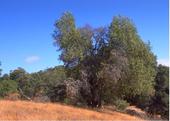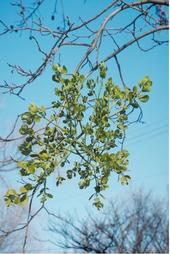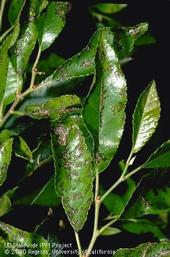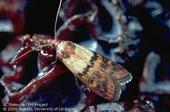- Author: Steven Swain

Sudden oak death (SOD) is a disease syndrome that has killed millions of native oak trees (Figure 1) along the west coast of the United States, from Big Sur in California up to Southern Oregon. The disease may involve several organisms, but its main driver is the fungus-like organism (known as water mold), Phytophthora ramorum. This plant pathogen is spread in the springtime by windy rainstorms. It infects the bark of oak trees, frequently creating bleeding trunk cankers that interfere with water uptake and sugar transport.
Death of SOD-infected trees can be accelerated by attacks from bark and ambrosia beetles. In the absence of beetle attacks, infected oaks may take years to die.
Many common...
- Author: Belinda J. Messenger-Sikes

(Credit: Jack Kelly Clark)
All mistletoes infest and grow as parasites on trees and large shrubs. In some cases, the host plant can be severely damaged. But recent studies have shown that broadleaf mistletoes can shelter and feed wildlife, including birds and small mammals. So, mistletoes are both parasitic plants and bird food!
Because mistletoes can damage trees, you may decide to do something about mistletoes infesting your trees. The first step is to find out whether you're dealing with broadleaf or dwarf mistletoe. Mistletoes differ in their life cycles, the damage they cause and management methods. UC Cooperative Extension Advisors Igor Lacan (San Mateo and San Francisco Counties), Steven Swain (Marin County) and Ed Perry (Stanislaus County,...

(Credit: Jack Kelly Clark)
Anthracnose is a group of fungal diseases that infect many trees and shrubs, causing dark lesions on leaves and cankers on twigs and stems. In some areas of California, vegetables and turfgrass can also be infected with anthracnose.
Symptoms of anthracnose vary by plant host and weather conditions. High humidity and dense canopies can exacerbate this common disease. Management relies on planting resistant cultivars of landscape plants along with careful maintenance of susceptible cultivars, such as pruning and removal of fallen leaves and twigs.
Authors Jim Downer (UCCE Ventura County), Steven Swain (UCCE Marin County), and Amanda Crump (UC Davis Plant Sciences) recently revised
- Author: Steven Swain
![Figure 1. Tree roots often grow near the surface when soil is compacted, or when the only water available comes from shallow irrigation. [S.V.Swain]](https://ucanr.edu/blogs/UCIPMurbanpests/blogfiles/31708small.jpg)
[From the August 2015 issue of the UC IPM Green Bulletin]
Although pine trees are comparatively drought tolerant, there comes a point where even hardy trees become stressed by lack of water. Stressed pines frequently exhibit symptoms such as thin, slightly yellowish canopies, or roots that "spider" across lawns (Figure 1). By the time pine trees begin turning brown, they are usually dying, but with some precautions, many trees can be saved before they reach this point.
California has a number of native bark beetle species that individually do only minor damage as they...
- Author: Steven Swain
- Author: Karey Windbiel-Rojas

[From the July 2015 issue of the UC IPM Retail Nursery and Garden Center IPM News]
Pantry pests sometimes find their way into our homes undetected and can infest stored products like flour, cereal, pasta, dried fruit, nuts, and even pet food. Often, by the time these pests are noticed, they have infested and contaminated foodstuffs and may already be reproducing in your home, making management difficult. Below are some tips to help you clean up, monitor, and prevent pantry pest problems.
What are Pantry Pests?
Beetles and moths are the two...


